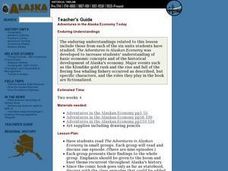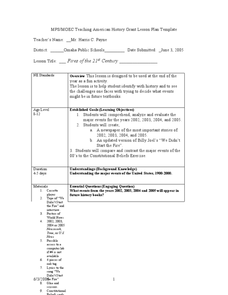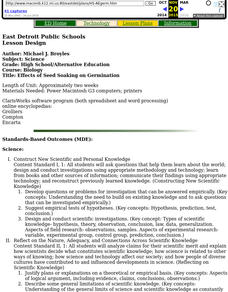Center for Civic Education
What Basic Ideas About Government Are Included in the Preamble to the Constitution?
Young historians explore the meaning of the Preamble to the US Constitution in this upper-elementary social studies lesson. Working with partners or in small groups, children discuss the purpose of government before reading and analyzing...
Curated OER
Our Classroom Constitution
Develop a system of classroom rules created by the kids, for the kids with this three-part lesson series on the US Constitution. After learning about the structure of the Constitution and the government it established, young...
PBS
The History of Book Banning in America
Harry Potter, Are You There God? It's Me, Margaret, To Kill a Mockingbird. Kids view a slide show and then discuss the seven banned books featured in the presentation and the reasons why the books may have been banned.
Curated OER
A Look at the History of Book Banning in America
Why do books end up on the banned book list? How do these banned books contribute to the literary canon? Start by showing the photo slide show, and discussing notably banned books. Then focus on some of the most popular objections:...
Read Works
A Constitution for Kids
What better day to celebrate the US Constitution than on Constitution Day! After reading a short passage about the different understandings of habeas corpus and ex post facto, sixth graders respond to 10 multiple choice and short...
Curated OER
Looking at Constitutions
Students work in groups to research and examine Constitutions from various countries. In this government and public interests lesson, students analyze primary and secondary documents to make a comparison between constitutional documents...
Curated OER
Constitution Lesson Plan
Third graders identify roles of Declaration of Independence and U.S. Constitution in establishing new country, create posters with their ideas about each part of Constitution, and explain three branches of government, including their...
Curated OER
Peace
Ninth graders explore through research changes in Japan following A-bomb, discuss how people of all ages can model tolerance and peaceful coexistence, examine Constitution of Japan, and identify its three basic tenants.
Scholastic
Now that You Have Them, What Do You Do With Class Rules?
Establishing classroom rules within the first two weeks of school is important. But what do you do with the rules after they've been created, and how can you establish them so that they have a lasting effect all year long? Use an...
Curated OER
Working Together As a Team
Students examine the need for rules to keep order at home, in school, in communities, and in the country using trade books and teamwork activities. They work in cooperative groups to define a positive learning community by writing a...
Judicial Learning Center
Your 4th Amendment Rights
Americans love to learn about their rights, especially those that protect them from the government's power to invade their privacy. Young people are especially engaged by this topic. An informative lesson explores four Supreme Court...
Curated OER
Adventures in the Alaska Economy Today: Enduring Understandings
Learners research the campaign to win statehood for Alaska and the constitution which was in place before statehood was approved.
Curated OER
Human Rights Arts Project and Research Paper
Students examine human rights abuses in thirty countries, specifically explore abuses in Dominican Republic's Trujillo regime, research one country with significant human rights abuses, use Preamble to U.S. Constitution as measure of...
Curated OER
United States Pride
Third graders learn the responsibility of citizenship and learn facts about a state they choose to research.
Curated OER
Amendment Process
Eighth graders examine the current amendments and discuss any change they would like to make. With a partner, they develop a proposal and an advertisement to redo at least two amendments. They also compare and contrast the amendments...
Curated OER
Living Under the Illinois Black Codes
Students use the text of the Illinois Black Codes to examine the laws in place. Using this information, they draw their own conclusions about why the laws existed in a free state. They also identify the purpose of these laws and how they...
Curated OER
John Jones and the Fight to Repeal the Black Laws
Students examine the role of John Jones and his fight to repeal the Black Laws of Illinois. Using the text of the law, they explore his reasoning for repealing the laws and the arguments he used to support his beliefs. They draw their...
National Constitution Center
Address America: Your Six-Word Stump Speech
Stump speeches are the focus of this exercise that combines politics and language arts. After learning about this type of speech, the class listens to Obama's 2008 presidential campaign stump speech and answers a series of questions that...
Curated OER
Fires of the 21st Century
Students explore historical perspectives. In this contemporary history lesson, students listen to Billy Joel's "We Didn't Start the Fire," discuss they lyrics, and add a new verse to the song for the years 2002, 2003, 2004, and 2005.
Curated OER
I'm Tellin'!: Kids Bringing Folktales Alive
Students participate in a reading lesson plan that works on social and academic skills. They increase reading comprehension with direct instruction with the group reading of a folktale. Then students research their own stories to tell.
Curated OER
Nothing to Fear but Fear Itself
Students investigate the years during World War II in which Japanese Americans living on the West Coast were held in internment camps.
Curated OER
Effects of Seed Soaking on Germination
High schoolers explain the standard growth pattern of a monocot seedling and word process a finished essay.
Curated OER
Breaking News English: World's Oldest Man Dies
In this English instructional activity, students read "World's Oldest Man Dies," and then respond to 20 fill in the blank, 15 short answer, 8 matching, and 8 true or false questions about the selection.
























